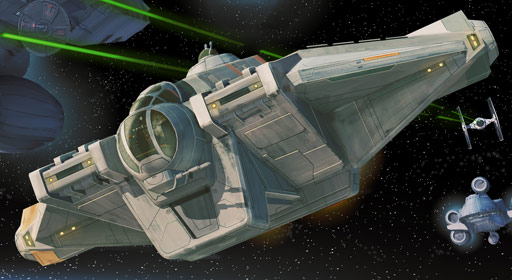 |
| A typical day for the crew of the Ghost. |
As mentioned previously, I have a set of dogfighting rules for Faith Corps with which I'm happy, and which have worked well. (Probably why I'm happy with them.) And I'm a sucker for dogfighting, especially in space.
If you know Star Wars Rebels, you'll know that there are two main ships in the show: the Ghost, a modified freighter that the crew calls home, and the Phantom, the little shuttle that docks in the Ghost's tail and serves as a small starfighter in times of need (so, like, always).
If you take a look at the linked character sheets for the Ghost and Phantom, above, you'll see they're mostly built like PCs, but not quite.
For one, they don't have approaches or disciplines -- instead, they have three plain ol' stats. These are Maneuver (how maneuverable the ship is), Speed (how fast its sublight engines are), and Systems (everything from the navicomp to the comms to the targeting computer).
When a character does something on a ship, if one of these stats applies, add its die (or dice) to the character's chosen approach and discipline. For example, if you're the pilot and defending against a TIE fighter, you'll roll an approach (probably Quick) plus Action plus Maneuver. If you're trying to chase that TIE fighter through an asteroid field before they can clear it and report your presence, you'll roll an approach (maybe Quick, but Careful wouldn't be bad either in a Star Wars-brand Asteroid Field™ where all the asteroids are way bigger than your ship but still float around mere yards apart from one another) plus Action plus Speed. If that doesn't work and you're trying to jam the TIE's comms, you'll roll an approach (Clever, perhaps?) plus Tech plus Systems. You get the idea.
These two ships have die ratings in all three stats, but that's not always the case. The Gozanti-class cruiser, for example, doesn't have a Maneuver die or a Speed die. They're fairly big and bulky, and, more importantly, they're likely the biggest ship that could appear in this game, so I don't need to account for, say, the maneuverability and speed of Star Destroyers.
The dogfighting bit is pretty simple. If your Maneuver die is lower than your target's Maneuver die, you need to use a free invocation on an aspect to be able to attack them. The "free" bit is important. Maybe you spend a round getting In Position, or maybe an allied pilot is your Wingman, or maybe the co-pilot uses the ship's targeting computer to get Locked On. (The Ghost and the Phantom can break this rule: Each has a dorsal turret that, if manned, lets the gunner attack any target regardless of its Maneuver die.)
(Compared to the dogfighting rules I used for Crimson Skies, these are barely there, but Star Wars dogfighting really doesn't care about, like, actual dogfighting maneuvers. It's all "Damn it, Wedge, where are you?" and "I can't shake him!" and "Thanks Wedge!" Wedge is heavily involved.)
I'd previously used defined game terms for ship-mounted weapons -- Accuracy, which adds to the attack roll, and Power, which adds extra damage on a hit -- but here I've dropped those terms in favor of framing that stuff as stunts. It's just one fewer thing to explain at the table. This way, the stunt spells out what to do. So I'd explain what Accuracy and Power are, but hey, look at the ships' weapons-oriented stunts instead.
As for defense, ships typically have shields, which here are basically free invocations on an aspect called Shields, but that seemed a little fiddly, plus treating it as an aspect implies that anyone can put more free invocations on it at any time. Instead, each ship has a number of check boxes, something like a stress track. Check a box and add d6 to your defense roll. When you're out of boxes to check, you're out of shields. Someone on board can use Tech to try to get more shields happening, and thus clear boxes, but they can't ever add more boxes.
Ships also have conditions, pre-defined just like PCs. Actually, this is where the pre-defined conditions-thing started -- with ships. However, anyone on board a ship can voluntarily take a condition to reduce a hit to that ship. This can result in cool things like Hera failing a defense roll while piloting the Ghost and ending up Irritated or Under Pressure. Because hey, just like in the show!
For NPCs, I build pilots and ships separately, even though those pilots are likely only ever going to act while piloting a ship. This way, I can keep the same three-dice thing the PCs use instead of trying to figure out some other way to achieve dogfighting parity. Big ships have gun emplacements operated by gunners, which gives them multiple attacks a turn and makes them as scary as they ought to be. For the She-Devils game, I attempted to scale things up by letting big ships step down the Power dice of starfighter-scale weapons -- sometimes two steps -- or even just say they're immune to weapons with a Power die of X or less. So they're easy to hit, with their lack of a Maneuver die, but harder to harm. Unless you have an advanced proton torpedo with 2d8 Power or something. I didn't really get to play out a lot of that, so I can't tell you how well it works.
All the dice business here makes a lot of this a little more difficult to translate to Fate Core. I'm not a fan of huge bonuses to dice rolls in my Fate games, so I'm reluctant to say "Just make it a +1 bonus for a d4, +1 per step above that." But I dunno, that's probably the easiest way to do it without changing a bunch of other stuff.

No comments:
Post a Comment